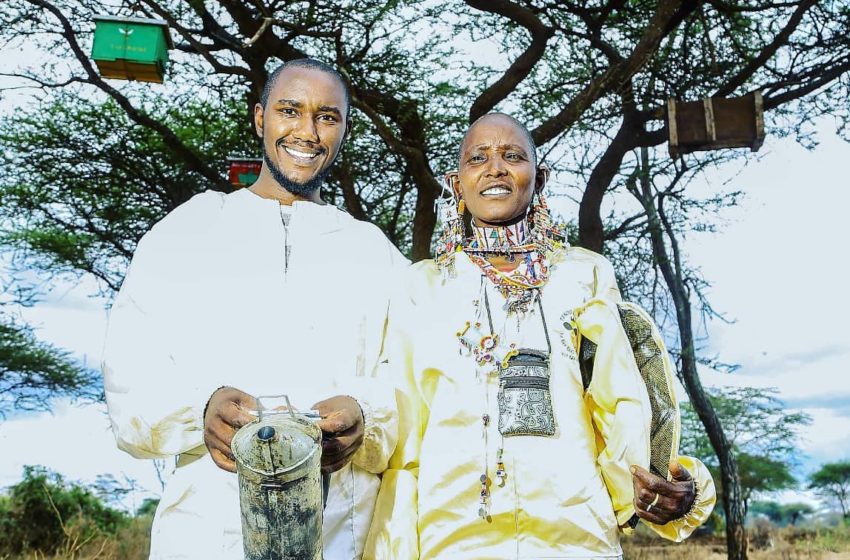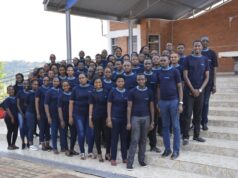
Nairobi
Across the sweeping savanna at the periphery of Amboseli National Park in Kenya, hives hang from acacia trees like pieces of artwork. The hives are painted in varied colours while some bear images of elephants, bees, and Mount Kilimanjaro whose snow-capped peaks are visible in the background.

Joyce Tokore a member and secretary of Inkasotuak Women Group which owns some of the hives says that beekeeping has brought more benefits than they had thought possible. “Beekeeping has helped restore the tree cover in the area and is also empowering us, women,” she says.
The 19 members of Inkasotuak meaning the “merciful ones” in Maasai are among a group of women, girls, and men in Kimana, Kajiado county that has benefited from an initiative by a local conservation organization called Happy Community. The initiative known as Adopt A Hive aims to empower local communities to make an income through sustainable beekeeping and in turn secure more land for wildlife within the Greater Amboseli ecosystem.
“The reason we formed happy community was to help restore wildlife habitats and migratory corridors that have been converted into other uses in the larger Amboseli ecosystem,” says James Njuguna, founder of Happy Community Organization. As a child, growing up in Kimana near the border of Kenya and Tanzania, Njuguna remembers that wildlife roamed freely in vast parcels of land predominantly inhabited by the Maasai outside the Amboseli National Park. Most of the land around the area was not subdivided but was owned communally in group ranches. But due to pressures of increasing population and development, the large chunks of land were fragmented into parcels of about 60 acres with each community member opting for different land use including agriculture and livestock keeping.
According to Levi Kavagi, Africa Coordinator for Ecosystems and Biodiversity Programmes at UNEP, wildlife migratory corridors around many protected areas in Kenya have shrunk in size threatening biodiversity. Kavagi notes that infrastructure development, human settlement owing to population growth and the search for more agricultural lands have all contributed to the destruction of crucial migratory corridors.
“These corridors offer connectivity between ecosystems and allow wildlife to migrate increasing their resilience, especially during calamities such as drought,” says Kavagi.
Amboseli is known for its large elephant populations with most being large tuskers. At a size of 392 Square Kilometres and hosting about 2,000 elephants, the park can barely hold all the wildlife with most roaming in the neighbouring community lands. In Kenya, the Government gazetted parks and reserves cover 8% of its territory but this area is too small to hold the country`s vast wildlife populations.
The majority of wildlife, inhabit private and communal lands like Kimana. Kavagi says that apart from the government gazetted protected areas, informal arrangements of protecting wildlife common among the Maasai have proven effective in curbing biodiversity loss and are currently recognized by UNEP as Other effective area-based conservation measures’ (OECMs) . “One of the policies that UNEP urges countries to adopt to protect biodiversity is the creation of protected areas which Kenya is implementing,” says Kavagi. Under this arrangement, the target for each country was to have at least 17% of their territory under protected areas by 2020.
Now in the Greater Amboseli ecosystem, an area of 5000 square Kilometers where more lands are being converted for largescale horticultural farming; livestock and wildlife jostle for space. That in addition to the community’s degradation of the ecosystem through deforestation for charcoal burning threatens the survival of Kenya`s iconic wildlife. Over the years wildlife numbers in Kenya have drastically declined with an estimated 68% decrease over 40 years between 1977 and 2016 due to habitat loss among other threats.
Adopt A Hive initiative aims to halt these trends. The initiative works with individuals and corporates from across the globe who adopt a hive at KSh. 6,500 (65 USD). The hives are distributed to community groups. Happy Community Organisation makes the hives and sets them up on the beneficiaries’ farms and monitors them to ensure they have bees. Twice a year, during the rainy seasons and when trees have flowered, the organization helps the beneficiaries harvest honey, and process and sell it. Honeybees source nectar from acacia trees that mainly cover the area. Once the honey is sold, 50% of the proceeds are sent to the groups via a cash transfer while 30% is put into a scholarship fund to support girls’ education within the community and 20% goes back to the organization to assist in monitoring and operations of the project.
The hives are custom made to the preferences of the donors. Donations go to making, maintaining hives, and harvesting honey. Since the organization set up the first hive in December 2019, it has progressively built and distributed 700 hives to groups. The beneficiaries have harvested 2,000 Kg of honey since February this year in one of the major harvests that are ongoing. Each hive can produce up to 10 Kg of honey with the organization selling each Kg at Ksh. 1,200.
Besides having an economic impact, the initiative has also been key in boosting the populations of bees which are crucial pollinators and could positively impact crop yields in the long run. According to UNEP, bees are among insects that are critical in ensuring global food production. “About 80% of all the food we eat is produced through cross-pollination by bees. If bees were to be wiped out for four years there would be a food crisis,” says Kavagi. But due to changes in land use for agriculture, degradation of natural habitats and use of pesticides bee populations have been on a sharp decline.
Joshua Pardio is one of the members of a community group of 12 members that harvested their honey for the first time in February this year. “Once we sell the honey we will either deposit the money in a bank account to educate our children or buy bulls for fattening,” he says.
Joshua who works as a ranger in Elerai Conservancy, a community-owned conservancy that neighbours Amboseli National Park where he is a landowner, is the patron of a girl’s group that is practising beekeeping. The girl’s group known as Noontimi comprises 15 members all aged 15-20 years.
“We came together as parents and landowners of Elerai and mobilised young girls mostly our daughters to join the project,” says Joshua. The girl’s group received 100 hives from Happy Community in January this year. Once they harvest the honey, Joshua says that the proceeds from the sale will be deposited in an account to help pay for the girl`s education. “Our girls know that money has been set aside for their education, ” says Joshua. By doing this, Joshua says that girls are encouraged to stay in school instead of opting for early marriages.
Happy Community targets women and girls as the main beneficiaries bearing in mind that they are marginalised both economically and socially within the community. Many girls end up dropping out of school due to early marriages and Female Genital mutilation.
“Sometimes girls are married off under the guise that parents have no money to educate them,” says Njuguna, a 27-year-old lawyer. Additionally, though women play a major role in tilling the land and looking after livestock, most of them do not own the factors of production leaving them with no income.
Besides, Maasai women who majorly rely on natural resources to earn a livelihood have been disproportionately affected by climate change. Like the rest of her village folks, Joyce says she is alarmed by unpredictable weather changes including persistent droughts a phenomenon that has become common over the past few years.
The beekeeping initiative has also played a role in the restoration of degraded ecosystems. “ No one can dare cut down a tree with a hive for fear of being stung by bees,” notes Joyce. Since receiving their donation of hives in August last year, Joyce notes that each member of Inkasotuak Group has planted at least four trees in a bid to reforest the area where there was rampant felling of trees for charcoal. Ecosystem restoration under this project is part of the efforts Kenya is making to curb biodiversity loss under UNEP`s Africa Green Stimulus Programme (AGSP).
Other efforts that Kenya is making to protect biodiversity under AGSP are through the implementation of the circular economy, blue economy, and the adoption of the wildlife economy.
In their little way, Adopt a Hive beneficiaries are also contributing to the country`s efforts to meet its commitments to reduce greenhouse emissions made during the Climate Change Conference of the Parties also known as the Paris Agreement in 2015.
“Kenya is among countries that made commitments also known as Nationally Determined Contributions (NDC). One of the measures under Kenya`s NDC to reduce emissions is through ecosystem adaptation aimed at building the resilience of nature and humans in the face of climate change,” says Kavagi.
Adopt a Hive Initiative which aims to build and distribute 20,000 hives in an area of 5000 square Kilometres by 2030 faces growing competition between different land uses including horticultural farming and livestock keeping and convincing landowners to opt for beekeeping to secure wildlife corridors can sometimes prove difficult. Kavagi observes that beekeeping is an effective way for communities to build climate resilience by offering a competitive alternative source of income. “Apiaries are a sustainable form of land use since they ensure the ecosystem remains intact. The income from honey also helps communities cope with the effects of climate change better,” he says.
In the long – term, the initiative hopes to produce honey for export and process other by-products such as bee venom to boost earnings. In years to come, Njuguna who grew up watching and learning about beekeeping from his father is focused on seeing wildlife freely roam within the Greater Amboseli Ecosystem like it did when he was a young boy one hive at a time.
This article is part of African Women in Media (AWiM)/UNEP Africa Environment Journalism Programme
Would you like to republish this article? Kindly contact janet@africanwomeninmedia













